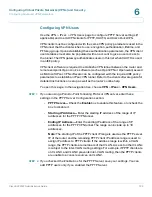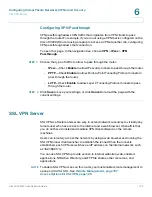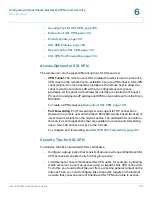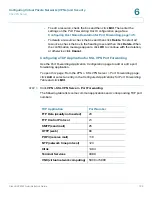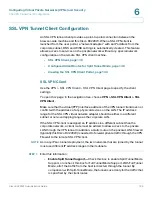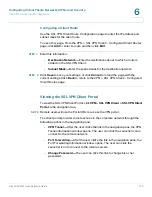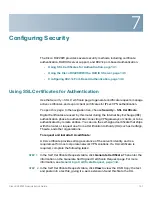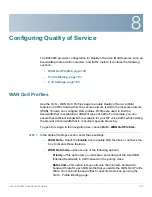
Configuring Virtual Private Networks (VPNs) and Security
SSL VPN Tunnel Client Configuration
Cisco RV220W Administration Guide
136
6
SSL VPN Tunnel Client Configuration
An SSL VPN tunnel client provides a point-to-point connection between the
browser-side machine and this Cisco RV220W. When a SSL VPN client is
launched from the user portal, a “network adapter” with an IP address from the
corporate subnet, DNS and WINS settings is automatically created. This feature
allows access to services on the private network without any special network
configuration on the remote SSL VPN client machine.
•
SSL VPN Client, page 136
•
Configured Client Routes for Split Tunnel Mode, page 138
•
Viewing the SSL VPN Client Portal, page 139
SSL VPN Client
Use the
VPN > SSL VPN Client > SSL VPN Client
page to specify the client
settings.
To open this page:
In the navigation tree, choose
VPN > SSL VPN Client > SSL
VPN Client
.
Make sure that the virtual (PPP) interface address of the VPN tunnel client does not
conflict with the address of any physical devices on the LAN. The IP address
range for the SSL VPN virtual network adapter should be either in a different
subnet or non-overlapping range as the corporate LAN.
If the SSL VPN client is assigned an IP address in a different subnet than the
corporate network, a client route must be added to allow access to the private
LAN through the VPN tunnel. In addition, a static route on the private LAN’s firewall
(typically this Cisco RV220W) is needed to forward private traffic through the VPN
Firewall to the remote SSL VPN client.
NOTE
As in any IPsec tunnel deployment, the two networks that are joined by the tunnel
must use different IP address ranges in their subnets.
STEP 1
Enter this information:
•
Enable Split Tunnel Support—
Check this box to enable Split Tunnel Mode
Support, or uncheck this box for Full Tunnel Mode Support. With Full Tunnel
Mode, all of the traffic from the host is directed through the tunnel. By
comparison, with Split-Tunnel Mode, the tunnel is used only for the traffic that
is specified by the client routes.

